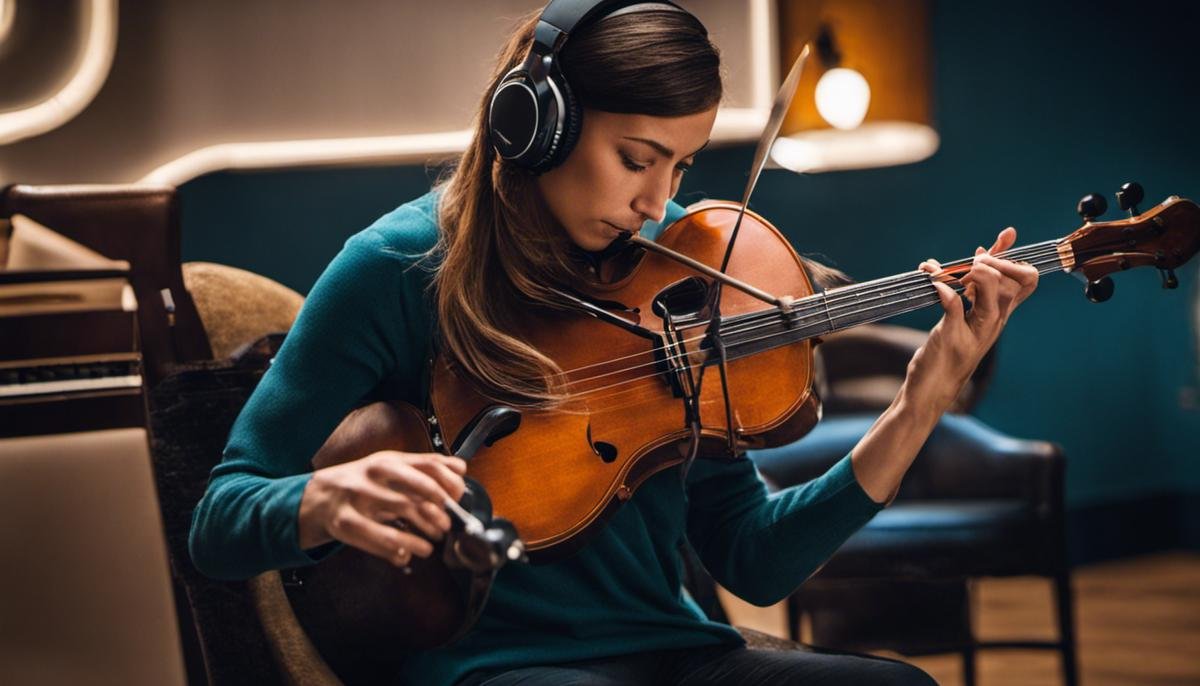
As our understanding of Autism Spectrum Disorder (ASD) continues to evolve, so does our approach to enriching the lives of those affected by it. Autism, a multifaceted neurological condition, presents unique challenges in social interaction, communication, behavior, and cognition. This complexity lends a certain urgency to the development of effective therapeutic strategies and techniques. Among these, music therapy has emerged as a field of significant interest. This innovative treatment leverages our intrinsic connection to music to aid cognitive and emotional development in individuals with Autism. Harnessing the power of rhythm, melody, harmony, and emotion, music therapy transcends traditional communication barriers, opening up new channels for skill development, self-expression, and social engagement.
Understanding Autism and its Challenges
Exploring the Known Causes and Common Challenges Associated with Autism Spectrum Disorders
Autism Spectrum Disorders (ASDs) have been the subject of fervent scientific study for several years, providing insights into the nuanced causes and the variety of challenges faced by those bearing this diagnosis. ASDs, while primarily categorized as developmental disorders, impact cognitive function, social interaction, and communication, offering a diverse array of facets for researchers to explore and understand.
Investigations into the causes of ASDs reveal an intricate and fascinating interplay of genetics and environment. Decades of twin and family studies indicate the robust presence of hereditary factors. Intriguingly, hundreds of different genes have been identified as associated with ASDs, suggesting that the genetic component to these disorders remarkably complex. Rare mutations with significant effects accompany these identified genetic precursors, further deepening the genetic complexity.
Nevertheless, genes do not tell the entire story of ASDs. The environment, both pre- and post-natal, plays a crucial role. Maternal health and lifestyle during pregnancy, including disease infections and exposure to harmful substances, have been correlated with increased autism risk. Post-natally, certain conditions during early childhood may also contribute to ASD development, although this area remains under extensive investigation. Thus, the causes of ASDs present a diverse and multilayered tableau.
In examining the common challenges associated with ASDs, it is crucial to underscore the notion of ‘spectrum.’ The array of symptoms and their severity can widely differ from one individual to another. Fundamentally, individuals with ASDs frequently encounter hurdles in social interaction and communication. They may exhibit difficulty understanding non-verbal cues, display untypical emotional responses, or struggle with reciprocal conversation.
Cognitive challenges are common and often subjectively impactful. At one end of the spectrum, individuals with high-functioning autism may possess normal to high intelligence but grapple with executive functioning skills such as planning, organization, and flexibility. On the other side, individuals with severe autism may present intellectual disability.
Sensory sensitivities often accompany ASDs, where regular sounds, sights, or touch can be overwhelming or underwhelming. This heightened or dampened sensitivity significantly influences behaviors and coping strategies.
Communication, cognition, sensory processing – every challenge requires unique consideration and individualized approaches to meet the person at their current capacity. The goal is always to enhance the individual’s quality of life and foster opportunities for growth and accomplishment.
ASDs are an extraordinary and critical domain of scientific focus. The exploration into their causes and common challenges shines a light on the richness and diversity of human neurodevelopment with potential to sustainably improve the lives of those with ASDs. This journey of understanding further underscores the essence of science – the ceaseless pursuit of knowledge to enhance the human condition.

An Overview of Music Therapy
The Science and Impact of Music Therapy in Autism Spectrum Disorders
As we delve deeper into the complexities associated with Autism Spectrum Disorders (ASDs), one intriguing avenue of scientific exploration lies in Music Therapy. This therapeutic intervention harnesses the power of music to address physical, emotional, cognitive, and social needs of individuals and has observed remarkable applicability in individuals with ASDs. The key lies in understanding the core mechanism of music therapy and how it can contribute to enhancing the lives of those with ASDs.
The underpinnings of music therapy are rooted in the brain’s intricate neural networks, which are known to respond to auditory stimuli quite uniquely. In fact, music has been shown to engage disparate regions of the brain, including the amygdala, which governs emotions; the hippocampus, involved in memory; and the frontal lobes, responsible for decision making and problem-solving. Thus, by carefully selecting appropriate musical activities, music therapists can induce desired neurological responses that can aid in addressing the challenges experienced by individuals with ASDs.
Music therapy in ASD functions on the principle of ‘neuroplasticity’, the brain’s ability to reorganize and adjust itself by forming new neural connections. This adaptability and flexibility make the brain more malleable to therapeutic interventions, such as music therapy. For instance, engaging individuals with ASDs in interactive music-making can stimulate neural synchrony, leading to improved communication and social interaction, a common challenge in ASDs.
Additionally, music therapy provides a structured, predictable, and safe outlet for self-expression. Through musical improvisation, song writing, and receptive listening, individuals with ASDs are offered a non-verbal medium to explore and express their emotions, thereby bolstering emotional well-being. This can be particularly beneficial for individuals whose verbal communication abilities are diminished.
Moreover, music therapy can assist with sensory sensitivities prevalent in those with ASDs. Musical rhythm provides a temporal structure that can help auditory, proprioceptive, and vestibular systems to cohere and integrate sensory information more effectively. By manipulating tempo, volume, pitch, and rhythm, music therapists can gradually attend to hyper- or hypo-sensitivities to sound, effectively using music not just as a mode of communication, but as a means to enhance sensory processing and integration.
The virtue of music therapy is in its adaptability—its application can be tailored to the specific needs and capacities of each individual. This pronounced individualized approach resonates with the very nature of ASDs, where symptomatic expression and severity can vary widely among individuals.
However, the establishment of music therapy as an effective tool does not detract from our continued quest for further answers and innovations in the realm of ASDs. As we delve further into the intersect of art and science, a multidisciplinary exploration remains pivotal to uncover novel strategies that can improve the life quality of those afflicted with ASDs. It is here that the true beauty of music therapy hangs in balance – it isn’t merely a science driven therapy, it is a harmony between science and soul.
In the grand orchestra of scientific exploration that aims to decipher and address ASDs, music therapy plays a vital note – a song composed of rigorous research, passionate application, and most importantly, individual triumphs. Such symphony of progress is yet another testament to the magic of how science, in symbiosis with art, can bring about profound transformation.

Music Therapy and Autism: Current Clinical Evidence
Music therapy, a burgeoning field in behavioral sciences, is gaining momentum as an effective therapeutic modality for individuals with Autism Spectrum Disorders (ASD). Empirical studies aver a sound neurological basis for the efficacy of this intervention in resolving some of the challenges associated with ASDs.
To understand this, one must first delve into the concept of neuroplasticity, a pivotal factor in music therapy’s success. Neuroplasticity refers to the brain’s ability to adapt, modify, and reorient its structure and functionality throughout an individual’s life in reaction to experiences and learning. This is especially relevant for individuals with ASDs, as it offers promising prospects for bridging cognitive and behavioral gaps.
Music therapy impacts communication and social interaction, areas often fraught with hurdles for individuals with ASDs. Integrative forms of this therapeutic intervention, like joint attention, call-and-response activities, and collaborative songwriting, serve to bolster speech generation and promote reciprocal communication. Research suggests an overall substantial improvement in verbal communication as well as non-verbal cues, vital for social interaction.
Moreover, music therapy offers a unique platform for emotional expression and ultimately, enhanced emotional wellbeing for individuals with ASDs. Music’s universal appeal transcends boundaries and invites engagement at a deeply personal level. It allows individuals, particularly those struggling with verbal communication, an alternative avenue for articulating emotions, leading to heightened self-awareness and – in many cases – elevated mood states.
Not to be dismissed is the role of music therapy in addressing sensory sensitivities, a common characteristic associated with ASDs. Many affected individuals exhibit anomalies in processing sensory inputs, which may result in either hypersensitivity or hyposensitivity to certain stimuli. Customized music therapy sessions provide a structured and controlled environment for sensory experiences, aiding in improved sensory processing and adaptive responses.
Apart from this, the versatile nature of music therapy allows for each program to be tailored to the individual’s specific needs – an aspect invaluable in dealing with the highly heterogeneous nature of ASDs. This mighty blend of prescribed medical intervention and creative fostering is an emerging recipe for success in novel therapeutic approaches.
Undoubtedly, the realm of ASDs and music therapy offers fertile grounds for further exploration and innovation. It serves as a testament to how the symbiosis of art and science can drive profound transformation in the lives of affected individuals. The interconnectedness of these fields subsequently prompts a thought-provoking discourse on our understanding of neurodevelopment disorders and therapeutic interventions.
In a world where science often takes center stage, the success of music therapy represents a critical reminder of the equally essential role of art in informing the human experience. Herein lies the promise of stepped-up research in this fascinating arena of neuroscience, psychology, and musicology. Indeed, the symphony of science and music presents itself as a beacon of hope for those navigating the multifaceted maze of Autism Spectrum Disorders.

Case Studies in Music Therapy for Autism
The therapeutic intervention of music therapy offers a unique avenue for individuals with Autism Spectrum Disorders (ASDs), postulating an intriguing era of discovery within the scientific and academic world. As a fusion of the humanities and sciences, music therapy provides a dualistic approach that both enchants and educates.
The understanding of neuroplasticity, a concept established in the early 20th century, divulges the brain’s innate capability to alter and develop new functional connections, placing it at the forefront of the effectiveness of music therapy in ASDs. This capacity for change remark former beliefs on the static nature of the brain, highlighting the cerebral cortex’s adaptability, influenced by environmental stimuli, notably, the therapeutic intervention of music therapy.
Communication and social interaction, often areas of significant challenge for individuals with ASDs, stand at the front line of breakthroughs found through music therapy. The non-verbal and straightforward nature of music cultivates a simplified platform for communication, reducing the complicated nuances and promoting expression without the difficulties frequently experienced. Increased interactions are observed when music is incorporated into therapy, bridging gaps between the spoken language and other forms of communication.
Emotional expression, an area often hindered in individuals with ASDs, is another field positively impacted by the integration of music therapy. The rich emotional content of music allows for feelings to be understood and expressed in a more direct way, circumventing the complexities of verbal language and offering an alternate avenue for emotional discharge.
One essential aspect of ASDs includes the sensory sensitivities that these individuals often contend with. Music therapy, with its broad spectrum of sensory inputs, provides a controlled environment for individuals to explore their sensitivities, fine-tune their response, and develop coping mechanisms, all within the safe scope of a therapeutic context.
The adaptability of music therapy is one of its most significant features, enabling therapists to customize programs for each individual with ASD, specifically targeting their unique challenges and strengths. This individualized approach increases the therapy’s effectiveness and fosters a groundwork for advancement and development in these individuals.
The symbiosis of science and art in music therapy plays a substantial role in driving transformation in individuals with ASDs. The artistic allure of music intertwined with the scientific underpinnings of its therapeutic use truly encapsulates the essence of human experience, showing promise for further research in this field.
The potential for music therapy to create profound change within individuals with ASD provokes an inspiring window of opportunity; a beacon of light reflecting an unexplored territory. The endless potential of music therapy as a valuable therapeutic intervention not only illuminates the beauty of science but serves as the embodiment of hope for those living with ASDs. Image this; a world for those with ASDs where communication, interaction, and emotional expression are not out of reach but are realities brought closer by the harmonious resonance of music therapy.

Photo by paul_1865 on Unsplash
The Future of Music Therapy for Autism
With music therapy firmly established as an effective therapeutic intervention for Autism Spectrum Disorders (ASDs), promising advancements lie on the horizon to fine-tune and expand the application of this innovative modality. Propelled by an unwavering academic curiosity and a deep-seated passion to improve the lives of individuals with ASDs, future developments in music therapy are bound to further amplify its therapeutic potential.
A fresh wave of interest is surfacing around the melding of technology and music therapy. By exploiting the captivating power of multimedia tools, novel ways of making music therapy more engaging and immersive are emerging. Virtual reality, for instance, could facilitate immersive environments where music therapy takes place, potentially enabling more profound therapeutic experiences. Moreover, advancements in artificial intelligence also hold promise in formulating hyper-personalized music therapy programs, taking into account the unique needs, responses, and development of each individual.
As the understanding of ASDs continues to deepen, new connections are being drawn between ASDs and rhythm processing. Rhythm, being a fundamental element of music, may play a pivotal role in developing social synchronization skills in individuals with ASDs. Encouraging synchronization with music, such as marching to shared rhythms or tapping to beats, could potentially enhance non-verbal communication and foster social bonding. Potentially, rhythm-focused therapy could also further the development and execution of motor skills.
Further, a deeper dive into brain-imaging techniques might significantly magnify our comprehension of the biological mechanisms underpinning the benefits of music therapy. For instance, improved understanding of how music-induced neuroplasticity contributes to the customization of music therapy sessions could open up exciting research avenues, propelling therapist’s ability to optimize interventions for each individual’s neurocognitive profile.
Building on the notion of interdependence between science and art, future directions could also see an exploration into a wide spectrum of musical forms, styles, and tools in therapy. This exploration could possibly break new ground in the discovery of additional therapeutic benefits from different genres and methods of musical engagement.
Lastly, an intensification in collaborative and interdisciplinary research is foreseeable: music therapists teaming with neuroscientists, geneticists, psychologists, and technologists. These collaborations aim to form a more holistic understanding of ASDs and the variety of ways in which music therapy can aid. Combined, these experts can more effectively wield the power of music to amplify the expressive capacities, emotional wellbeing, social skills, and overall quality of life in individuals with ASDs.
As we propel forward in the pursuit of further understanding and innovation, we are encouraged by the immense potential that the field of music therapy holds for individuals with ASDs. Undoubtedly, the future is bright, resounding with the harmonious symphony of science and art working in tandem to usher significant transformative changes.

The evolving tapestry of music therapy for Autism continues to fill with inspiring stories of transformation, steadily becoming a beacon of hope for affected families. The power of music to enable socio-emotional development and enhance cognitive abilities is increasingly recognized within clinical settings. However, like any emergent field, it is marked by areas of uncharted territory, ripe for exploration. Anticipating the future, one can expect continuous innovation in music therapy techniques and robust scientific endeavors seeking to consolidate its evidentiary base. Among the myriad forms of therapeutic interventions available for Autism, music therapy holds a unique promise – a promise that orchestrates the symphony of progress, delicate as a lullaby, and powerful as a crescendo.




